Love is... neurochemistry? This week, we look at love from a scientific perspective. We go looking for love in the brain and explore the chemistry behind falling, and staying, in love! Plus, how ovaries become damaged with age, and the new virus strain with pandemic potential.
In this episode
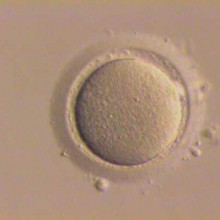
01:16 - DNA break-up ages eggs in ovaries
DNA break-up ages eggs in ovaries
It's a sad fact that a woman's egg cells don't last forever, and we eventually lose our fertility. Women are born with over a million potential egg cells, but only 500 turn into mature eggs, and they're almost all gone by the time a woman reaches her early 50s. But this happens at very different ages for different women, suggesting that there's a hefty genetic component in the mechanisms driving our biological clocks.
And now new research published in Science Translational Medicine this week 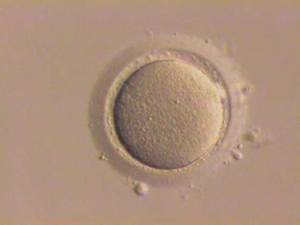 shows that the age-related decline in the quality and quantity of a woman's eggs may be linked to problems with a vital DNA repair pathway involving a couple of infamous genes - BRCA1 and BRCA2.
shows that the age-related decline in the quality and quantity of a woman's eggs may be linked to problems with a vital DNA repair pathway involving a couple of infamous genes - BRCA1 and BRCA2.
These are breast cancer genes, so what are they up to here? Well, the BRCA genes normally help cells to repair DNA damage throughout the body, and they're a potent way of helping to prevent cancer - this explains why people with faulty BRCA genes are at a greater risk of breast, ovarian and prostate cancers. But as we age, these repair mechanisms get less efficient, and damaged cells accumulate. The lead researcher of this work, Kutluk Oktay at New York Medical College, noticed that women with faulty BRCA genes coming to his fertility clinic tended to produce fewer egg cells, so he wondered if these repair mechanisms might also be at play in the way that egg cells degrade over time.
The scientists started by looking in mouse and human eggs for DNA damage - specifically the double-strand breaks that are usually repaired by the BRCA genes. They found that this kind of damage piled up in the egg cells with age, suggesting it was no longer being repaired properly. They then tested whether it was actually the BRCA genes playing a role, by knocking down the levels of the genes using a technique called RNA interference and finding that there was even more damage than usual. They also engineered mouse egg cells with extra amounts of BRCA1 and found that older eggs with an extra dose could survive DNA damage as well as eggs from younger mice.
To confirm that the findings hold up in real live women, the researchers looked the ovaries of young women with faults in their BRCA genes. They found that women with faults in BRCA1 had smaller reserves of egg cells in their ovaries, while mice with faulty BRCA1 had smaller litters than genetically normal animals. And although both humans and mice with faulty BRCA2 genes seemed to have no fertility problems, the scientists suspect that the effects of this gene may come into play later in life.
It's important to stress that the scientists haven't yet directly linked faulty BRCA genes to fertility problems, but this paper has opened up a whole new avenue of research in this area. Once the researchers have pinned down what's actually going on at a cellular level, they hope to find ways to slow down age-related loss of fertility.
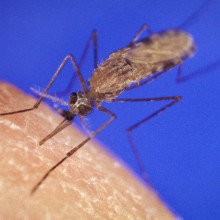
04:53 - Synthetic biology: making anti-malarials
Synthetic biology: making anti-malarials
Mark - I've got a story in this week's edition of Nature which is really a milestone in the battle against malaria, but it's also a milestone for science of synthetic biology. Now, this involves adding a genetic code to a living organism to get it to do something useful that it wouldn't ordinarily do. In this case, it's about engineering a yeast with an extra dozen or so genes to produce a precursor to a malaria drug. Seven years ago, Jay Keasling who's a Biochemist at the University of California in Berkeley showed that you could genetically engineer yeast to do this. Fast forward to a conference a couple of weeks ago in Nairobi, Keasling found out that for the first time, Sanofi which is a big pharmaceutical company has used this process to make 39 tonnes of artemisinic acid which is a precursor to the grade A best available malaria treatment out there.
Ben - That's not an insignificant amount of material they have made there.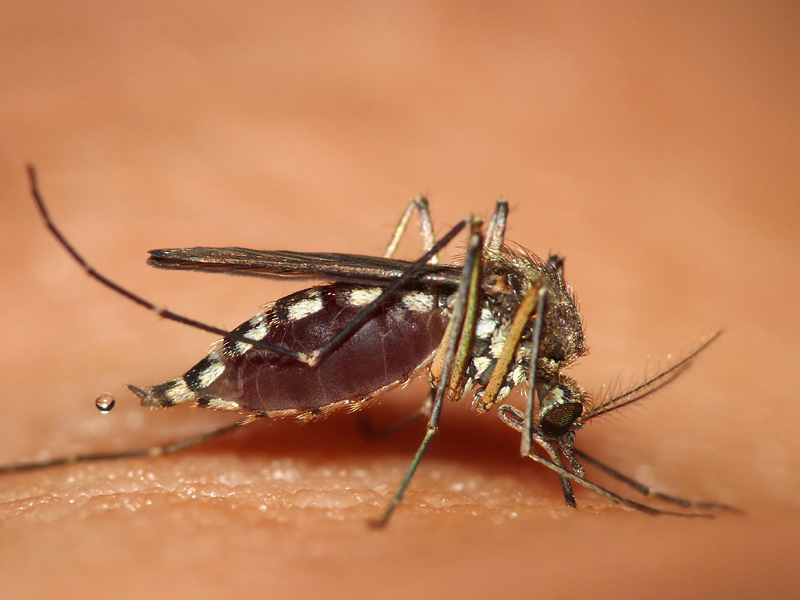
Mark - It's huge. You could convert it to about 40 million treatments, something like that. So, that might be between 20 and 30% of the total number of treatments they've dispensed in a year.
Ben - How does that compare to more traditional drug manufacture technique?
Mark - Well, this is interesting thing about this. At the moment, the only source of artemisinin therapies which are the different types of molecules, all based on this stuff that are used in the drugs. The only source of it is the sweet wormwood plant Artemisia annua which is grown in places like China, in Vietnam. The fact that the only source of this drug comes from this plant has caused the market to be incredibly volatile for these drug compounds. The prices have fluctuated massively, supply has fluctuated massively, and it's partly because from growing the plant to producing the drug is an 18-month cycle, adding erratic donor funding, and it's made it very difficult to actually predict production. This new synthetic biology derived form of the drug, the idea here is that this will kind of smooth out those bumps in production of the drug.
Ben - Are we sure as well that it's identical, it's chemically identical to the drug that they would've made with the normal factory process?
Mark - Well, it is and at the moment, all the dossier of information is in with the World Health Organisation so that they can verify that that's the case. But it should be within months that they should sign off on that. So, it's feasible that we could expect to see malaria medicines made using this process in pharmacies in the developing world by the end of the year.
Kat - In theory, this is the kind of technique they should be able to work for also some other drugs that are derived originally from natural compounds as well.
Mark - In theory, that's right, Kat. This is something that people working in synthetic biology, this is one of the key things you can do. If you can find a microbe to make your drug, rather than going through many, many different chemical reactions to make potentially, you can make it more quickly and more easily. One of interesting things about this though is that the engineered yeast gets you so far, but it still requires four steps of good old traditional chemistry to actually take you on to the drug. So, they have to work hand in hand.
Dan - Drug companies are often a bit shy of spending a lot of money developing things for diseases like malaria. Are they going to make the effort this one?
Mark - Well, one of the reasons that Sanofi did this and funny enough, everybody I spoke to about this story was quite happy to talk to me about this. Sanofi was a little harder to pin down and that's strange because they're doing an amazing thing that could help millions of people. It's interesting. A lot of the money to come up with the development of the process has come from charitable funding from like the Gates Foundation and places like that. And more of the motivations for them, as well as looking good, that's a clear motivation that they're very affront about. It makes them look good. It potentially stabilises a market that they already feed into because Sanofi is one of the drug producers that buys in processed sweet wormwood plant to turn into the drug and it's hit by market fluctuations just like everybody else. So, it's looking for a way to stabilise that, but the other thing is, they've been given several million dollars by donor funders to develop a really neat bit of chemistry and a really neat bit of production level synthetic biology that they could then apply to other more commercially lucrative drugs. So for them, the interest is in being able to get some effectively free support to develop new in-house technology which is then there's. That's their proprietary technology in there.

15:07 - (Power) Walk This Way
(Power) Walk This Way
A group of US and Chinese researchers have developed a generator that can convert footsteps into electrical power, which may pave the way for large scale energy harvesting in urban areas.
We are surrounded by enormous amounts of wasted mechanical energy - our footsteps might propel us forward, but a lot of their kinetic energy is also lost as vibrations into the floor. Moving cars lose energy into the road, and the power of ocean waves causes walls (and coastlines) to crumble. There have been a number of efforts to harvest this type of ambient mechanical energy, as it's known, but it has generally been focused on a much smaller scale - harvesting vibrations to power small sensors for example. But the team led by Zhong Lin Wang at the Georgia Institute of Technology, Atlanta, have used nanotechnology to produce a triboelectric nanogenerator, capable of producing large electrical power outputs, and with impressive efficiencies.
Moving cars lose energy into the road, and the power of ocean waves causes walls (and coastlines) to crumble. There have been a number of efforts to harvest this type of ambient mechanical energy, as it's known, but it has generally been focused on a much smaller scale - harvesting vibrations to power small sensors for example. But the team led by Zhong Lin Wang at the Georgia Institute of Technology, Atlanta, have used nanotechnology to produce a triboelectric nanogenerator, capable of producing large electrical power outputs, and with impressive efficiencies.
The nanogenerator comprises a polymer and gold sandwich. The top layer consists of two polymers, PMMA [Poly(methyl methacrylate)] and PDMS [polydimethylsiloxane], with a thin layer of gold in between.
The bottom layer consists of a block of PMMA coated with gold nanoparticles. When you walk or step on the generator, these two layers come into contact. Electrons from the gold nanoparticles flow into the PDMS layer, resulting in surface charges on each layer (negative on the gold, positive on the PDMS). As you lift your foot off the generator, the two layers separate and a potential difference (voltage) is produced, which drives electrons through the system; these can be tapped off as an electrical current. The nanoparticles are necessary to provide a large surface area than a flat gold surface would, dramatically increasing the number of charges that can accumulate. And each time the nanogenerator is stepped on, this cycle of charge build-up - separation - flow is repeated, scavenging energy as you walk.
To demonstrate the power of this effect, Wang and his team produced a nanogenerator smaller than a human palm which generated an instantaneous output power of 1.2 W. While this may not sound like much, it is enough power to light a bank of 600 coloured LEDs with a single human step!
The generator has an efficiency of 14.9% - i.e. it converts almost fifteen percent of the kinetic energy in a footstep into electrical energy. This compares favourably to other harvesting technologies like turbines and photovoltaics, but has the added benefit of producing power instantly, and the nanogenerator is not weather-dependent.
So the potential for this technology is vast. Maybe soon, we'll be powering our own disco dance floor!

18:58 - Soft robots take a leap forward
Soft robots take a leap forward
When you think of robots do you think of leaping bits of silicone powered by explosions?
Probably not, but researchers based at Harvard University in the US have made just such a device.
The small triped is simply made from commercial silicone that's moulded into a simple shape with a valve at the end of each leg.
When a mix of methane and oxygen is pumped into the hollow legs of the robot and lit with a spark the two gases quickly react and cause an explosion and a large amount of expanding gas that deforms the robot causing it to leap high into the air.
In fact, the researchers don't know quite how high their 1cm robot can leap because they were testing it in a 30cm high container and it the robot hit the top.
Explosions might not seem the ideal way to power robots but it's how our cars get us to work every day - sparks make the petrol combust and the resulting gases drive the engine.
This soft robot, though, is much simpler, and cheaper, than your car's engine or more traditional mechanical robots. It's hoped one day this soft squidgy robot could jump over obstacles in disaster sites with the added benefit of it not mattering too much if it gets lost or broken.
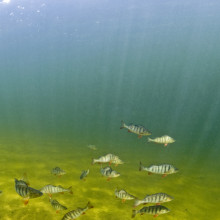
23:15 - Fish on Pharmaceuticals
Fish on Pharmaceuticals
Psychoactive drugs, such as the anti-anxiety drug Oxazepam, can get into rivers in biologically relevant concentrations and may be altering the way that fish behave, according to research published in the journal Science this week.
Many pharmaceuticals are known to make their way into wild waterways. Once excreted by medicated humans, they travel through water treatment plants and can remain stable in effluent for some time. Little is known about the effect of this pharmaceutical pollution. Any directly toxic affects should be easy to identify, but when these chemicals are designed to effect a behavioural change, such as anti depressants or mood altering drugs, the impact may be more subtle.
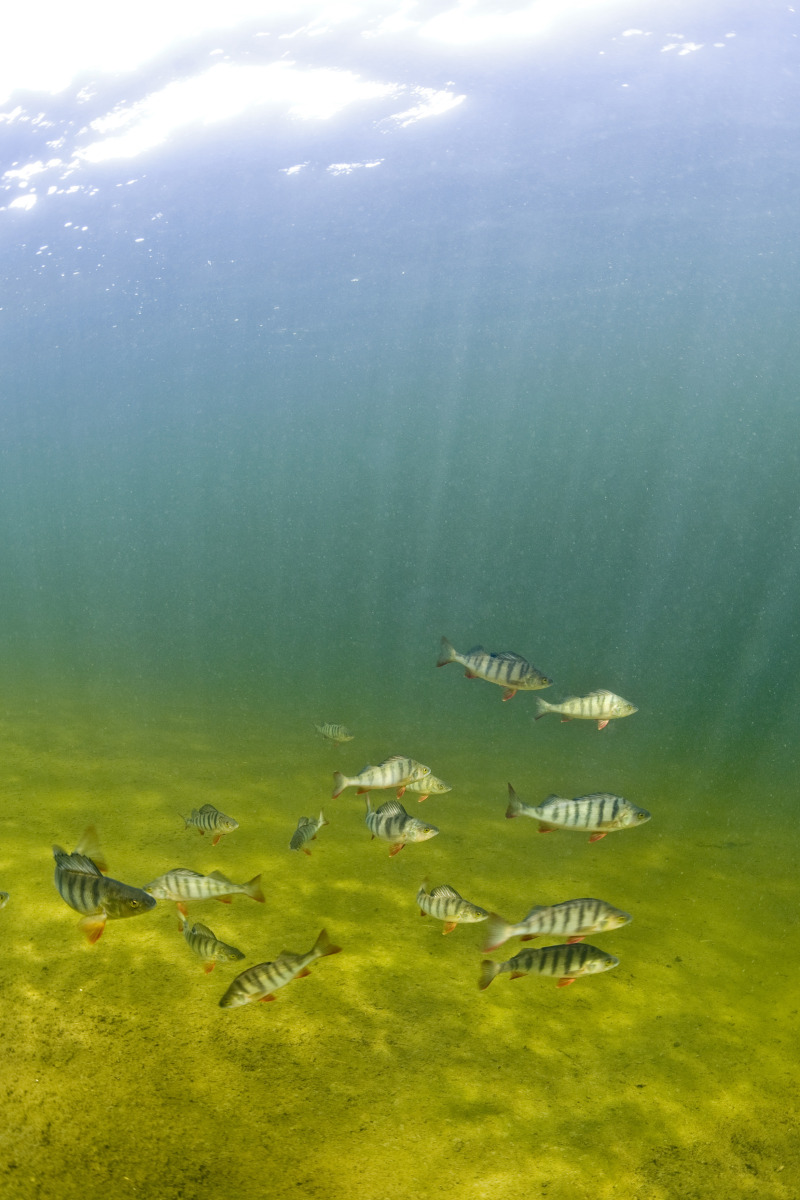 Dr Thomas Brodin and colleagues at Umeå University, Sweden, noted that the concentration of a certain anti-anxiety drug, oxazepam, in river water was around 0.58 µg per litre, but was actually concentrated up to six times higher in the muscle of the European perch that lived there. Could this, they asked, alter the behaviour of the fish?
Dr Thomas Brodin and colleagues at Umeå University, Sweden, noted that the concentration of a certain anti-anxiety drug, oxazepam, in river water was around 0.58 µg per litre, but was actually concentrated up to six times higher in the muscle of the European perch that lived there. Could this, they asked, alter the behaviour of the fish?
To find out, they looked at three behavioural traits: boldness, activity, and sociality in both treated and untreated fish. These traits are known to have an impact on population dynamics, and are relevant for both the ecology and evolution of the fish.
Fish exposed to Oxazepam were more active, more likely to explore new areas and less sociable, and the extent mapped onto the dosage - the higher the concentration of drug in the water, the more significant these behavioural changes became.
What's more, as a result of these changes, the "behaviourally modified" fish ate more food, and would deplete a food resource more quickly. This suggests that the presence of anti-anxiety medications in rivers may be altering food web structures, and ecologically changing waterways in hard-to-predict ways.
Beyond the ecological concerns, could fish be concentrating medications that are then returned to the human food chain? Probably not, as co-author Jonatan Klaminder explained:
...and, as the half-life of oxazepam in humans is around 12-14 hours, that's a lot of fish to pack into one meal!

25:59 - Coronavirus
Coronavirus
with Wendy Barclay, Imperial College London
A new and deadly strain of virus thought to have originated from contact with infected animals in the middle east is raising concerns as evidence mounts that it can also pass from human to human. To find out more, we spoke to Professor Wendy Barclay who is Chair in influenza virology at Imperial College London.
Ben - First of all, what is this virus?

Wendy - Well, this virus is a coronavirus, but a virus in quite a large family that includes viruses of both humans and animals. The name suggests that it's got a special appearance. It's got some spike-like proteins on the outside which under the electron microscope look a little bit like crowns. Hence, the corona and the virus is carrying inside it an RNA genome which of course we know makes viruses a little bit more mutable than viruses which rely on DNA for their genome. Coronaviruses are quite notorious in the RNA-genomed viruses as being extremely large. They have really the largest RNA genome of maybe up 30 kilobases in length which is large for a single piece of RNA. Until sort of around about 2002, 2003, the only coronaviruses that people knew about that infected human beings were two rather mild corona viruses that caused common colds. And then of course along in 2003, came SARS coronavirus which hit the scene and made everybody sit up and realise that these coronaviruses could also cause much more serious disease, and that again seems to be what we're seeing here this time around as well.
Ben - So, how does this coronavirus then and this particular strain differ from other respiratory infections like influenza?
Wendy - Well, in many ways, there are some similar features. Particularly with severe forms of influenza, for example, the H5N1 bird flu when it does infect humans, causes a very severe lung involvement, viral pneumonia, severe respiratory illness, and that seems to be so far what's being seen in these 11 people now that appear to have been infected with the new coronavirus. So, there are some similarities there. Indeed, it could be said really that SARS was also a virus which causes a sort of very much a lower respiratory infection. That differs is I guess from typical common colds and most strains of seasonal flu which although there can be lung involvement really, are also infecting the upper respiratory tract and passing amongst people quite readily through the air.
Ben - You said we've had 11 confirmed cases of this so far, so it obviously is quite a new strain. Where do you think it's actually come from?
Wendy - So, genome sequencing suggests that this is really highly related to viruses which are found in bats. Again, since the SARS epidemic, a lot of work has been done on coronaviruses and looking for new viruses because we think that SARS in fact came originally from bats, although it seems that SARS went through other animals first to sort of adapt and allow it to cross that species barrier and get into humans. This virus actually seems much more similar to viruses which are in bats, suggesting that it may not have gone through an intermediate animal species, but may have come directly across from bats into humans. But to be honest, the animal source of the infection which most have originated in Saudi Arabia, the animal source of these infections really is not identified.
Ben - And this has been making the headlines primarily because it seems to have been able to go not just from bats to humans but actually, from one infected human to another. Why is that such a concern?
Wendy - Well, when we have these viruses that are usually present in animals and it cross once into an exposed person, we call that a zoonosis. And although that's very unfortunate for the infected person because often, that's accompanied by severe disease, it doesn't necessary trigger an outbreak. A lot of animal viruses can, following a big dose exposure can cause this zoonotic event, but when we get really worried is when there are new viruses which cross from an animal species and they have the capability to pass from one person to another. Now, I should stress that although this corona virus have hit the headlines because it appears to have done that. The case of human to human transmission which we're certain about is in a family member, following what we think is quite close contact, and in fact, the recipient that the person that seems to have caught the virus from a family member is themselves somewhat susceptible to viruses. We don't know the medical details but we have understood that they have some predisposition to make them particularly susceptible. So, this human to human transmission event that's been seen with the new coronavirus does not necessary mean that this virus has the ability to transmit readily from people through the air, in a manner which we would begin to think was heralding a new pandemic.
Ben - And obviously, we do have to be careful not to alarm people. How can the medical community now be vigilant or what are we looking out for before we know that we may need to take action?
Wendy - Well, the signs of this virus are pretty severe. We're talking about severe respiratory illness. Some of the patients have experienced kidney failure as well, but it's not clear whether that's direct consequence of virus infection or whether it's associated with the multi-organ failure that goes with such a severe respiratory infection. The Health Protection Agency is looking at this very seriously. They're very much involved. They have diagnostic tests available and I'm quite sure that clinicians involved in sort of caring in ITU's to these kinds of patients will be strongly encouraged to submit those diagnostic tests and confirm cases as soon as possible.
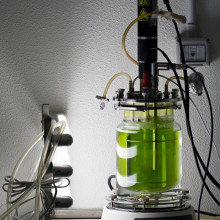
32:42 - Extracting oil from algae - Planet Earth
Extracting oil from algae - Planet Earth
with Simon Thomas, Plymouth Marine Laboratory
As a clean renewable source of energy, algae is great in theory. Not only does it take in CO2, but some species produce useful quantities of lipids or fats which can be converted into biofuels. But earth scientists have hit a snag, how do you actually extract these useful chemicals? Planet Earth podcast presenter Richard Hollingham met Microbial Ecologist Simon Thomas at the Plymouth Marine Laboratory.
Simon - We're in a constant temperature room at the moment, so this is actually set to 15°C and we're surrounded by bottles of algae growing gently in the light and also some larger volumes of algae. Here, we have 10 litres of various algae. So, we have a column as you can see which is bubbling air through it in front of a light source and that's very basic of what we do.
Richard - It looks like an oversized fluorescent tube full of this green liquid and it's bubbling from the bottom up to the top and that's a particular type of algae.
Simon - The one in there is actually Dunaliella Salina. It's of commercial interest because it produces beta-Carotene at certain stages of its life cycle. The bubbles are there to keep it moving but they are also there to help gas exchange, so it gets oxygen out and CO2 in.
Richard - And these, you described as photo bioreactors. So, what is a photo bioreactor?
Simon - It's the algal equivalent of a fermenter. So, in a fermenter, 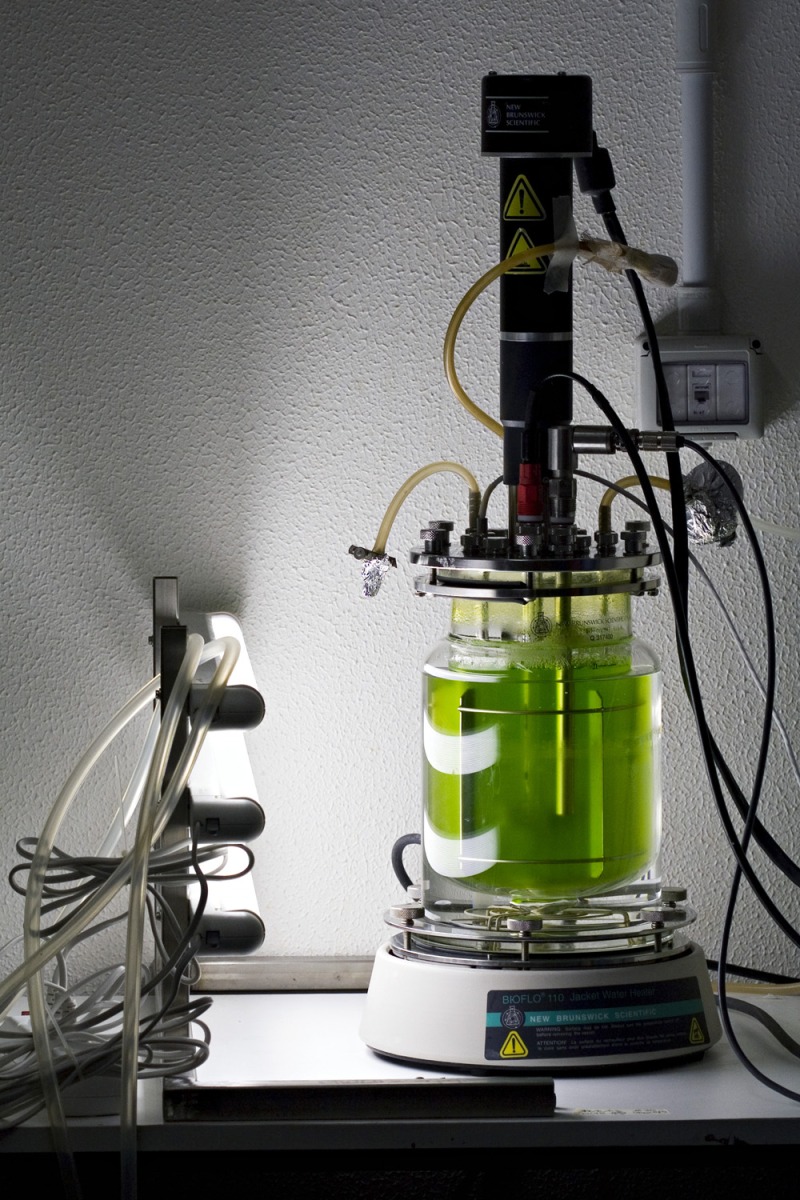 technology is very old and it grows commercial scale amounts of bacteria or yeast typically. These are an attempt to take that technology onto algae and it is to add a certain degree of control that is very hard to do in an open pond system.
technology is very old and it grows commercial scale amounts of bacteria or yeast typically. These are an attempt to take that technology onto algae and it is to add a certain degree of control that is very hard to do in an open pond system.
Richard - And ultimately, you're looking at products from these, but you are looking at how to get those products out.
Simon - We are, yes. For any future development of biodiesel from algae, one of the most important thing is to try and get the product out, but also for the other applications of algae - pharmaceutical uses, cosmetic uses, you still need to get the product out of the cell. Typically, they're produced within a cell and breaking the cell open is very difficult with algae. They're very resistant to stress. So, we're trying to find some novel ways of breaking them apart. One of the ways we're looking at is using viruses that infect the algae and they naturally break the cells apart. We're looking at novel mixing technologies which use things like beads impregnated metals and enzymes from bacteria that would naturally break apart algae. So, we're very much going back to nature in order to find a way of trying to solve this problem. It's quite tricky and it is taking an awful lot of time and an awful lot of people are looking at this at the moment. We have had some success.
Richard - And if you imagine an individual microscopic algal cell, so that's a single plant cell effectively. How much of that is oil and how much oil can you breed for it to produce?
Simon - Normally, you would say something like 10% to 15% would be oil but we've developed some strains of algae that produce up to 40% lipids and what we're trying to do is, normally, they would only accumulate these lipids late on in their life cycle. And we're trying to get them to actually produce this oil early on whilst they're actively growing, but of course, there will always be a balance between growth and storage material so we're trying to solve that particular conundrum.
Richard - So, you've got one of these columns just under 2 meters high, full of algae. A sizeable percentage of that is lipid, is potentially oil, but the getting out is the challenge.
Simon - Well, the scary thing and one of these columns here would only be about 1 gram of oil.
Richard - Okay.
Simon - So, one of the challenges for the future is actually scaling up these systems to meet the massive demand there would be, but even in a very good system, in 10 litres, you'll be lucky if you've got more than 2 or 3 grams of oil. So, you need to come up with a very large solution or maybe find a way to grow even denser, which again, is something we're looking at.
Richard - Now, if we came out of this room, into the main laboratory here, you have scaled this up. So, this is fairly big room And at its centre is almost another room which is full of these tubes running horizontally rather than vertically.
Simon - Basically, you split the volume of the tube into a manifold and the idea is trying to maximise the amount of light the algae gets whilst minimising the amount of time they've spent before the oxygen is removed. So, when oxygen gets too high for a photosynthetic organism, it becomes toxic. It is a balance between exposure to light and the amount of CO2 they take up and the amount of oxygen they produce. So, this has been designed in collaboration with a big engineering firm and we worked out the formula based on their experimental design and we've come up with this particular design.
Richard - Is that continuously replenishing or is it the algae sort of sitting there and doing its thing?
Simon - The algae just flow through the tubes and the idea is you get turbulent flow within the tubes so the algae actually go from the middle to the outside and it maximises their exposure to light and it also maximises their ability to get rid of the unwanted gases and take up CO2.
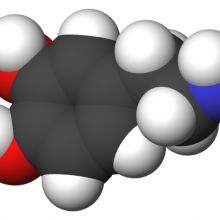
37:50 - What is Love?
What is Love?
with Dr Alex Kogan, Cambridge University, Dr Gert J ter Horst, University Medical Center Groningen
People speak about having 'chemistry' with a partner but little is known about what actually happens in our brain when we fall in love. On Valentines Day we wanted to investigate the science behind romance. Kat Arney was joined by Dr. Alex Kogan from Cambridge University and Professor Gert J Ter Horst from the University Medical Centre in Groningen.
Kat - So Alex, in your scientific opinion, what is love?
Alex - Other than a headache you mean?
Kat - I think other than a major headache for many people.
Alex - It's a really timeless question. People have been wondering about this particular question probably since the beginning of humanity. I think my best hack at the answer would be to say that it's quite a few motivations. It's emotions. It's behaviour. I would say love is some of the best stuff in your life and some of the worst stuff in your life. And so, it's got a lot of complexities. When we think about different types of love, we've got everything from friendship love to love of a romantic partner, to love of cheesecake, and it makes studying love extremely difficult and so, as this new era of studying love from a neuroscience, a genetic perspective starts to really emerge we're trying to work out all these details and complexities.
Kat - So, forgetting the kind of love of cheesecake which I really do understand, when we talk about romantic love, the kind of love celebrated with Valentine's Day, what do we know so far about what's going on in the brain?
Alex - There has been a few studies done on this and the work is really preliminary I would say, but what we know is, when we look at a romantic partner for example compared to a stranger, we do see more activation and the dopaminergic component of the brain where a lot of the reward aspects are processed. So, we know that aspect, but beyond that, I think we're still trying to learn some of the details because of the methodological design challenges of capturing something as loose and complex as love.
Kat - And we hear a lot in the media, the media loves to talk about this hormone called oxytocin. It's the love molecule, it's the cuddle hormone - really?
Alex - I would say not really, to be honest and so, what's interesting about oxytocin is, we see it across animal kingdom. It's pretty ancient. By the best guesses, I think it's been around for at least 700 million years and so, a lot of the work that started out on oxytocin was first in animals. What they found was when they administered oxytocin to rats for example, to mothers who hadn't died giving birth, they started showing a lot of maternal tendencies and when they restricted oxytocin, even the rats that had given birth started to act a lot more cruelly to their children. So that was a big indicator of maybe maternal love. And then with prairie voles for example, they found that, "Hey, they have much more of this distribution of the oxytocin receptor network which seems to be regulating the monogamy whereas with other species of voles, you don't see the same distribution and you don't see monogamy." So then we move on to the human work and there's been evidence that it's related to things like trust, and empathy and love, but in the last couple of years, we're starting to discover the dark side of oxytocin. Now, we're seeing things like, it promotes more jealousy and greed, and potentially envy, and gloating and so on, and so forth. So, I think it's a very complex molecule that does a lot and we're really starting to just learn about it.
Kat - I want to bring in Gert here as well because love isn't just about these kind of feelings of closeness and trust or even this kind of evil, dark feelings. Love is very pleasurable and not just sexually pleasurable. Being in love is nice. We know from other studies that chemicals like dopamine are involved in these things of pleasure. Does the same apply to love?
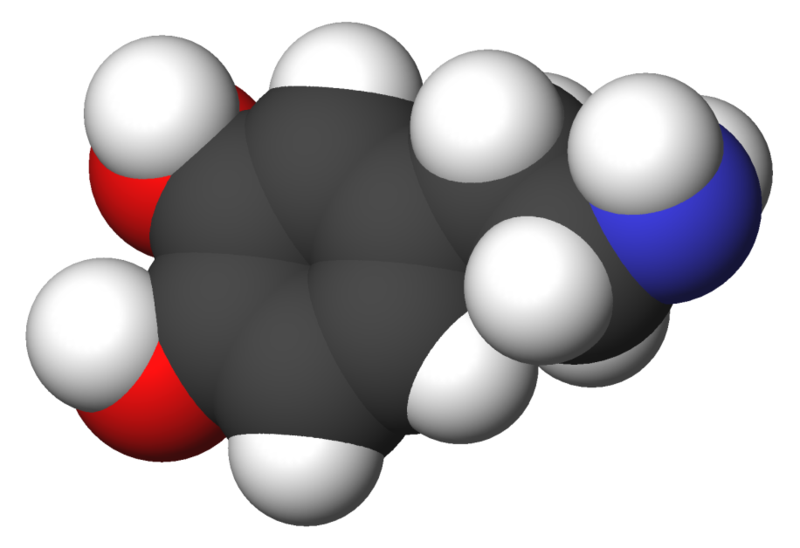
Gert - I would say, it does, but we only have indirect evidence for a role of dopamine in love. When we studied the MRI scans that are made, we do see activation of region that contain a lot of dopamine, but that's only indirect evidence. What you actually would like to do is study the role of dopamine for example in PET scanners and as far as I know, that haven't been done.
Kat - It's not very romantic, being in a PET scanner though.
Gert - No, it's not and also, being in an MRI scanner is not very romantic. It's a lot of noise.
Kat - Do we know about any other chemicals in the brain that might also be involved in this kind of pleasurable feelings of falling in love?
Gert - No, I think there's some idea about the role for serotonin for example. We know that serotonin is critical for mood and when you're in a happy mood when you're in love, I would say serotonin particularly must be involved, but also, that is indirect evidence because as far as I know, not many studies have been done on the neurochemistry of love, not in humans anyway.
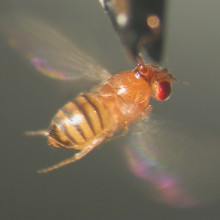
42:43 - How do male and female brains differ?
How do male and female brains differ?
with Jonny Kohl, MRC Laboratory of Molecular Biology
How do male and female brains differ? Investigating fruit flies has given us an insight into the neural circuits that control courtship. Naked Scientist Hannah Critchlow spoke to Johnny Cole, a postgraduate student at the Medical Research Council Laboratory of Molecular Biology in Cambridge...
Johnny - I'm interested in differences between the male and the female brain because if you look at animals, in most species, males and females behave quite differently. And now, our big challenge is to explain at the level of neurocircuits, so at the level of how individual nerve cells in the brain wire up into circuits to explain those differences at this level.
Hannah - And what animal are you looking at?
Johnny - We are studying the fruit fly brain just because the human brain is a lot, lot more complex than the fly brain. So, fly brains have about a million times fewer nerve cells, so they are a lot easier to study than the incredibly complex human brain and also in flies, we have very powerful genetic tools to monitor, to activate or inactivate signal cells in the behaving fly.
Hannah - And you mentioned that you're looking at behaviours between males and females in the fly. What kind of behaviours are different?
Johnny - So, we're looking at innate behaviours. So, those are behaviours that the flies don't have to learn, so they're just being born with the knowledge of how to perform this behaviour and specifically, we're looking at one type of behaviour, courtship behaviour. So, male flies, they will try to approach the female flies, so they start following the female fly around, then they'll try to sing a love song for the female fly so they tried to serenade the female fly, then they will try to lick and touch the female fly, and eventually, try to copulate with the female fly. And during all that time, female flies respond quite subtly to those courtship attempts by either becoming docile and they let the male do its thing or if they're not impressed by the male courtship attempts, they will just kick the male in the face, literally.
Hannah - And what's controlling these different behaviours then?
Johnny - So, that's specifically what we're trying to find out. So, we know that there's one type of chemical signal, a so-called pheromone, it's called CVA. It's controlling courtship behaviour. This chemical signal leads to completely different behaviours in males and females. So, when males smell this pheromone CVA, they increase their aggressiveness and they're in general repelled by CVA whereas females increase their receptivity when they smell this chemical signal. That's quite interesting because they have the same physical stimulus, CVA, that leads to completely different outcomes behaviourally in males and females, and that's what we're looking at.
Hannah - And it's usually the males that emit this pheromone, this chemical CVA.
Johnny - Exactly.
Hannah - And so, what brain differences have you found between the males and the females that give rise to these different responses then?
Johnny - So, for the last 3 years, I've been recording electrical activity from single nerve cells in the fly brain when we present this pheromone to the living fly. Of the many of those recordings, I've found that there's different responses to that pheromone in brain centres that process the smell. So basically, the pheromone CVA is detected by the fly's antenna - that's the olfactory organ of the fly and there, it activates the first nerve cell. This nerve cell then talks to a second nerve cell and the second nerve cell then talks to a third nerve cell, and that's the basic circuitry for pheromone perception to fly brain. And I'm now recording activity from the third nerve cell.
Hannah - And this simple 3-nerve cell circuit is there in both male and female flies.
Johnny - Exactly, so the first two nerve cells are identical in males and females, but I found at the level of the third nerve cell, there's a difference between males and females. So, if you take the analogy of a train on rail tracks, so imagine that the pheromone signal is the train and the rail tracks are the cables with which the nerve cells in the circuit communicate. In both sexes, the train on rail tracks goes past the first station, so the first nerve cell on the antenna. It goes past the second nerve cell deeper in the brain, but then at the level of the third nerve cell, something different happens. It can go either left or right. So, in female flies, the train would turn left and go to one part of the fly brain. In male flies, the train would turn right and go to a different part of the fly brain. And we've identified now that there's a circuit which at the level of the third nerve cell that tells the train to go either left in females or right in males.
Hannah - And do you know what that signal switch is? What's controlling whether it goes left or right?
Johnny - Yes, we found that surprisingly, this switch is controlled by a single gene. It's called 'fruitless'. This gene occurs in a male and a female version, and we found that when we engineer female flies that have the male version of this gene, the switch is set in a male manner.
Hannah - And then what happens to these female flies with this different switch?
Johnny - So, these she-males as we call them, they start behaving like males. So when they smell the pheromone, they would get on their hind legs and start boxing, so they display male typical aggressive behaviour.
Hannah - Do you think there's a similar system in humans?
Johnny - That's a long standing question. Many people are interested whether humans can actually perceive pheromones. The problem is that the human brain is very, very complex and it's hard to study those kind of questions in people. So, we know that the human brain has the anatomical potential to perceive pheromones, but as far as I'm aware, there hasn't been conclusive proof of the existence of human pheromones. So, at the moment, we just don't know, but it would be very interesting to find it out.
Hannah - And you're now coming to the end of your PhD. Do you want to stay and research, do you think?
Johnny - Absolutely. I'm planning to do a post doc and I will potentially want to investigate whether the same mechanism is in operation and more complex brains.

49:14 - Staying in Love
Staying in Love
with Dr Alex Kogan, Cambridge University, Dr Gert J ter Horst, University Medical Center Groningen
Falling in love involves a little understood rush of chemicals, including oxytocin and seratonin. But in humans relationships can be formed for decades. We wanted to find out how long this 'honeymoon period' lasts for and how these chemical signals change over time.
Ben - We are still joined Alex Kogan and Gert J Ter Horst. So Alex, how does a reaction to these chemicals change over time?
Alex - Great question. Poorly understood I would say. You know, there's only a handful of studies that have really been done in terms of humans and studying love, in terms of scanner. I'm not really aware of much work in terms for oxytocin, look at levels as they track. We do know that the course of love does peak in terms of the early phase, in terms of this manic, 'I want to be with you all the time' phase and then cools off to govern this great state of passion to more companion state as it goes on, and it becomes more tender and more about connection and commitment. But in neuroscience, we're quite away from really understanding because of all the challenges that are involved in trying to study a topic like this.
Ben - Gert, do you have any idea about how this rose tinted vision that we  have during what we call quite rightly the honeymoon period? How does that seem to affect the pathways in our brain?
have during what we call quite rightly the honeymoon period? How does that seem to affect the pathways in our brain?
Gert - How it affects our pathways, I don't know, but what we've done currently is we are measuring using pupil dilation to see how long this period actually lasts and pupil dilation is a measure of our emotions. What we do is we show people a picture of their partner and then we studied them over time and what we've seen that it's probably less or something like ten months.
Ben - Is that all that? It does not seem like a very long time, isn't it?
Alex - Okay, I'll take it.
Ben - And sad as it may be to bring up, but what happens at the end of a relationship? Heartbreak can feel like a physical illness. It really hits you hard. Do we know what's going on chemically during that period?
Gert - What chemically is going on? I don't know, but we've just completed an MRI scan for approximately 100 people who have gone through breaking up of a relationship and what we see is a big difference between men and women. In women for example, we find a lot of inhibition in the brain when they're confronted with a photograph of their ex-partner which is significantly less in men. What we also see is that women suffer greatly from heartbreak really at the beginning and after 6 months, this wears off, and in men, we see the opposite. They start rather happy after a breakup, but they end up in a serious breakup problem after about 6 months.
Alex - Do you know how that also maps onto maybe the different roles of being the breakup-er and the breakup-ee? Because you can imagine the person that's doing the breaking up initially feels relief, they're great. I got into this relationship I wasn't happy about and I have the initial boom and then later on, they realise, well, wait there were all this wonderful things I had that are now gone whereas for the breakup-ee, they get hit with the misery right away, but maybe they could start the healing process a little earlier.
Gert - Yes, we also studied that aspect, but since we have not yet completed the study and we were running the final analysis right now, I cannot really discuss this yet.
Ben - Well, on a more positive note, do we know what changes occur that help people to stay together? Do we see particular patterns of brain activity in couples who have been together for a very long time?
Alex - I suppose there is some evidence from animal models where again, the prairie voles, in terms of distribution of say, the vasopressin network or the oxytocin network. So, we could say those systems are likely involved, but the work with humans is early. The first studies really with humans with oxytocin generally begin until the 2000s I would say, picking up with nasal sprays. And so, I think we're so really trying to figure out what happens in a moment and we haven't really started to touch on a lot of these more interesting longitudinal effects.
Ben - It seems surprising to me that something that has concerned mankind for all eternity, is something that we've only recently started studying.
Alex - It's funny you mentioned that because pre-1970s, there was really almost no research in psychology on love. Zick Rubin was one of the pioneers who started the work and during his dissertation, they said, "Well, why are you studying this? Nobody has done it." He said, "Well, the lit review could be very short" and now, it's much longer because there's been a lot more work done, but it's so complex. A lot of the work is often - well, we need to narrow the scope, not study love of everything which will include cheesecake, but I will study just the passionate love which is a very particular type of romantic love of companionate love or unconditional love, and it's one of the most complex topics that we know of.
Gert - And we have to do longitudinal studies as well to follow people because that has not been done yet.
Alex - Yeah, not at all.
Ben - And just quickly, Gert, we were talking about dopamine earlier. We know that dopamine, as well as being involved in reward, it's very frequently evolved in addiction. Do we think it's possible that long term relationships may just be a case of being addicted to each other?
Gert - This has been studied in one MRI study in the US where they showed that people who were still in love after 25 years and happily in love, so they claim they were as much in love as when they just met, and these people, they have a pattern of brain activity that resembles addiction, so it could be.
Ben - So, it really could be that we are just simply addicted to one another. I think that's quite a nice way to end and of course, Robert Palmer said that "You're going to have face it. We're addicted to love." That was Alex Kogan from Cambridge University and Gert J Ter Horst from the University of Groningen.

55:03 - Are Humans Meant for Monogamy?
Are Humans Meant for Monogamy?
Larry - Hi. This is Larry Young, Professor of Psychiatry at Emery University in Atlanta. Most people have defined monogamy as a long lasting sexually exclusive partnership between mates, but in reality, this sexual monogamy is very rare in animals. When biologists speak of monogamy, they generally are referring to social monogamy or a pair form a long lasting relationship, but there's occasional cheating. Prarie voles, beavers, marmosets, and 90% of bird species are socially monogamous. Rats, mice, cats and deer are examples of species that mate promiscuously. I believe that humans have the capacity for monogamy which is not true for 95% of mammals. Our brains evolved the ability to form enduring bonds that results in socially monogamous relationships that last well beyond the initial sex. The neuromechanisms that give us the capacity to form bonds do so by creating the emotion that we call love.
Monogamy evolves in situations where it takes two to raise offspring or where the likelihood of finding a partner is low. Humans have a long dependency on parental resources and it's likely that pair bonding evolved to ensure that the offspring are provided with the resources needed to succeed. However, I do not believe that humans are biologically sexually monogamous. In most species that biologists consider monogamous, there is also cheating. Cheating can increase fitness by increasing the number of offspring for males, or by diversifying the genetics of the offspring for females.
- Previous The wonderful world of RNA
- Next Are Humans Meant for Monogamy?










Comments
Add a comment